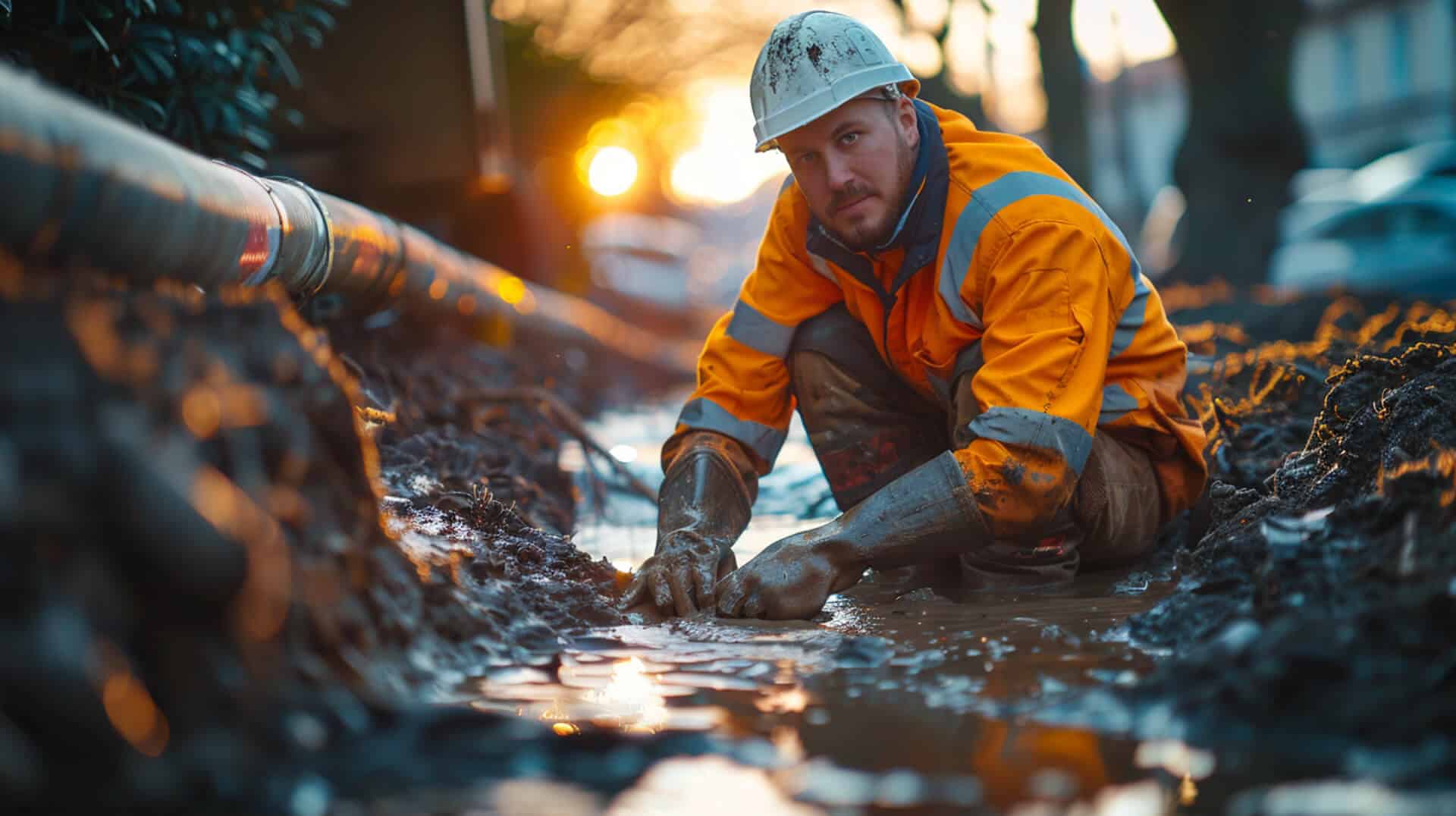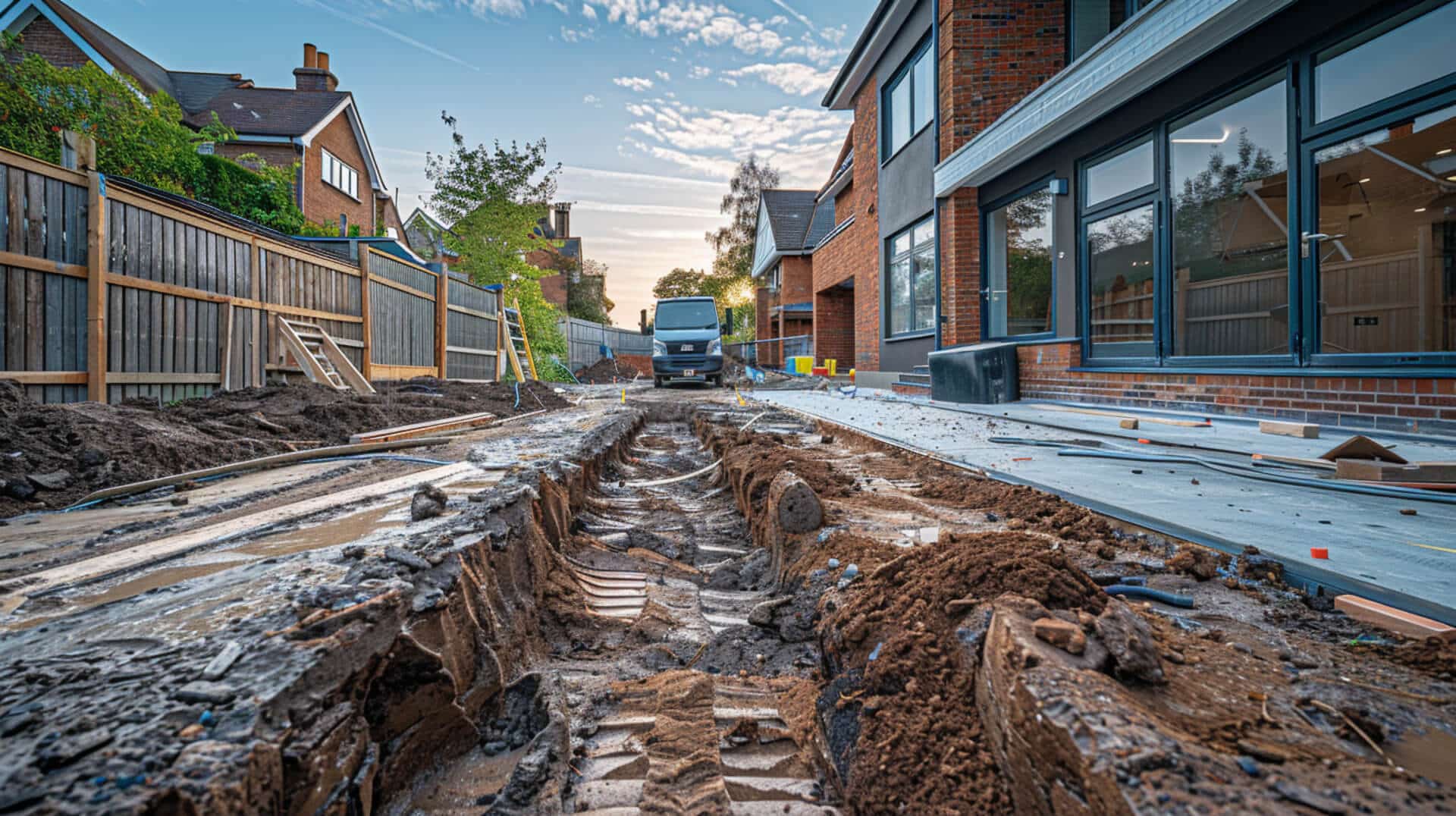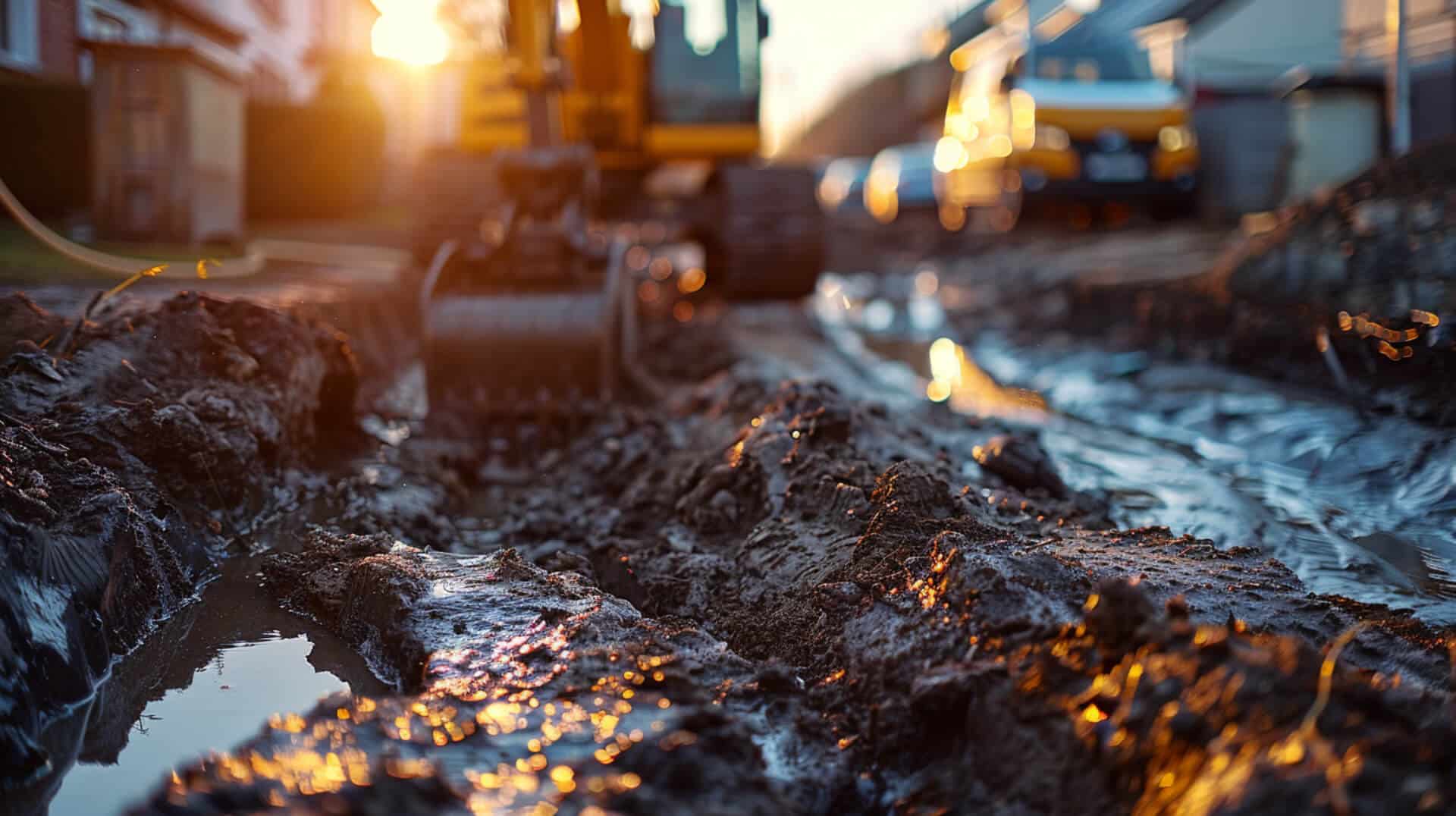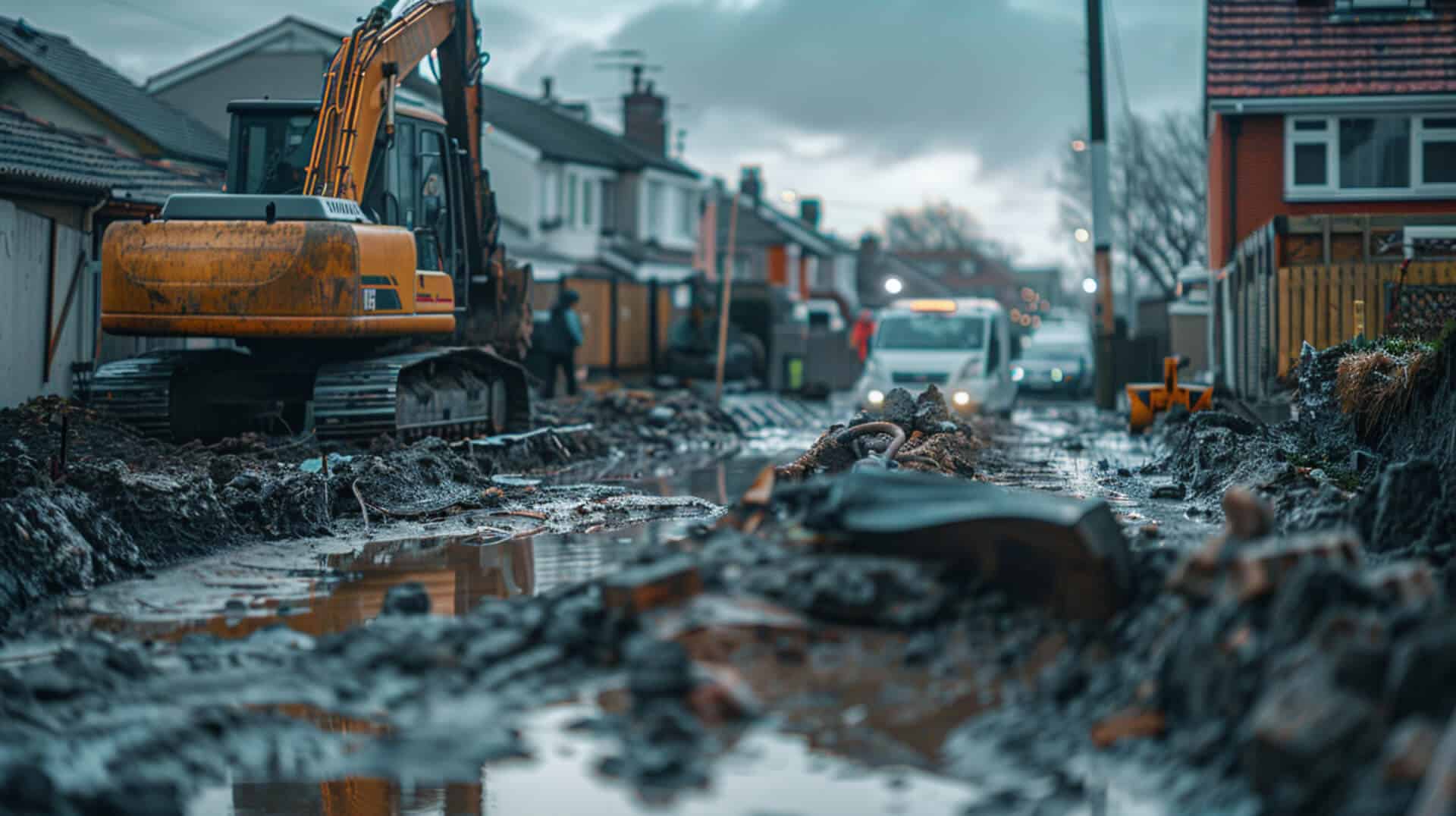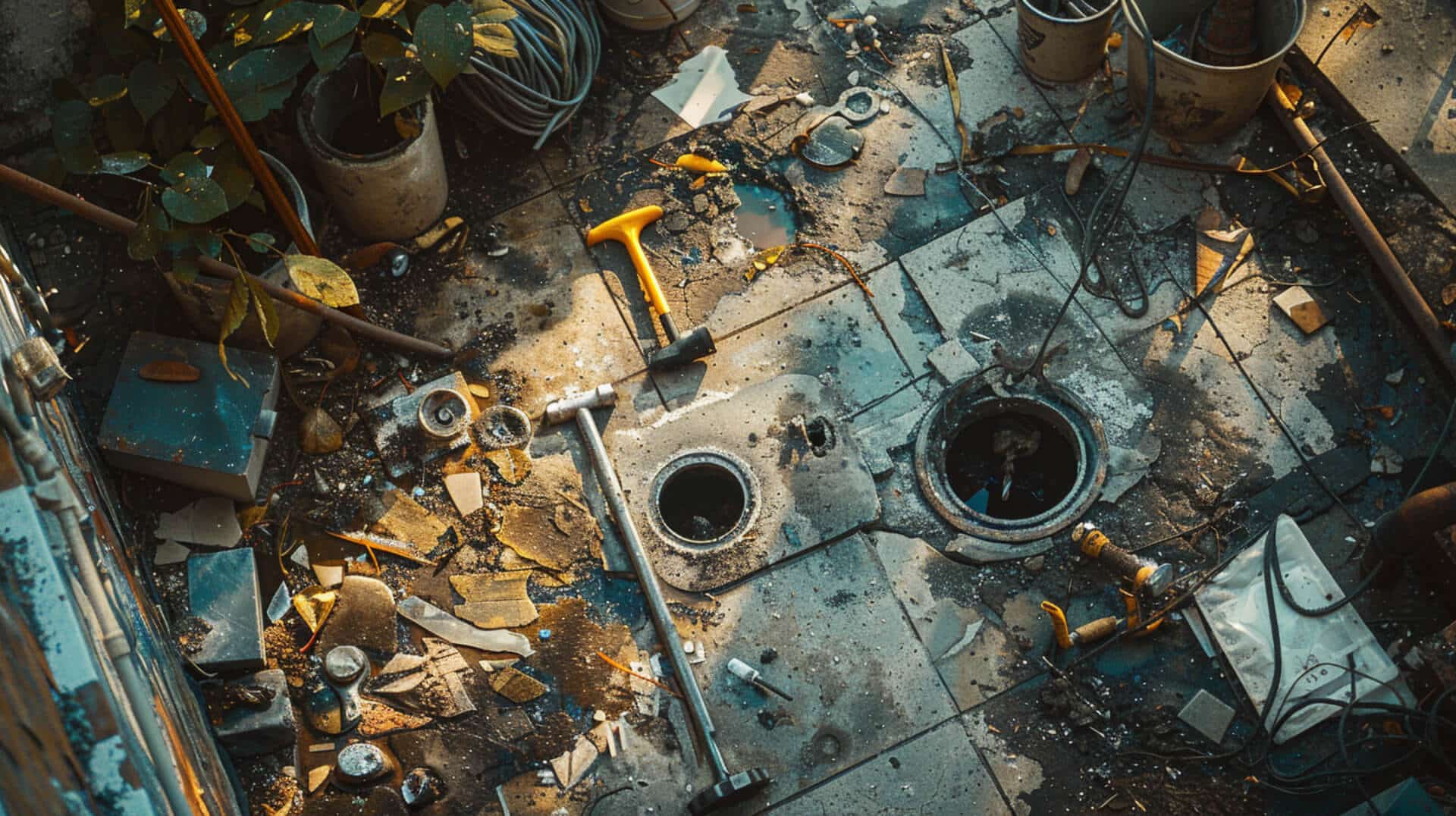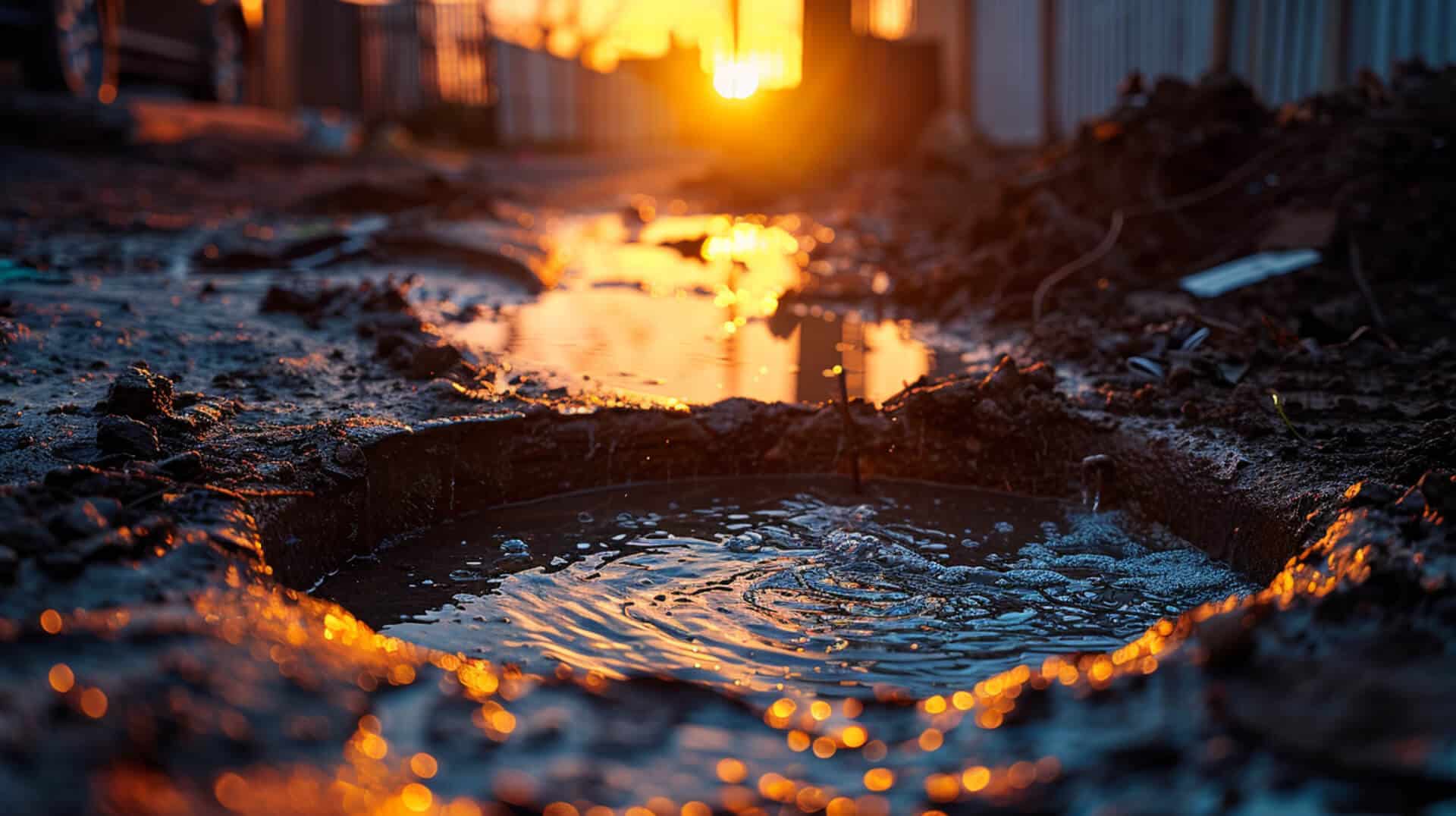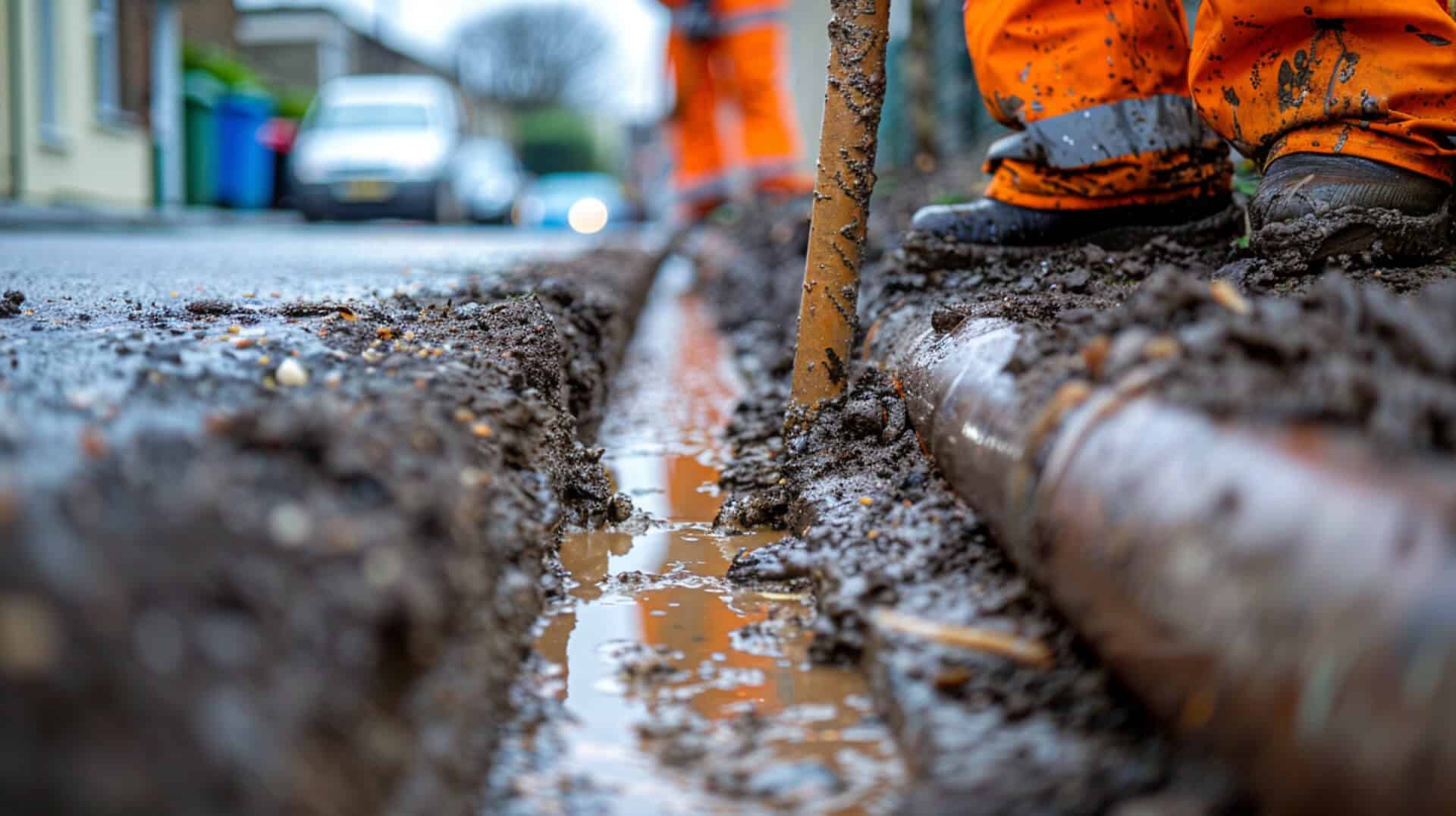 What Are The Potential Risks Or Complications Of Drain Excavation
What Are The Potential Risks Or Complications Of Drain Excavation
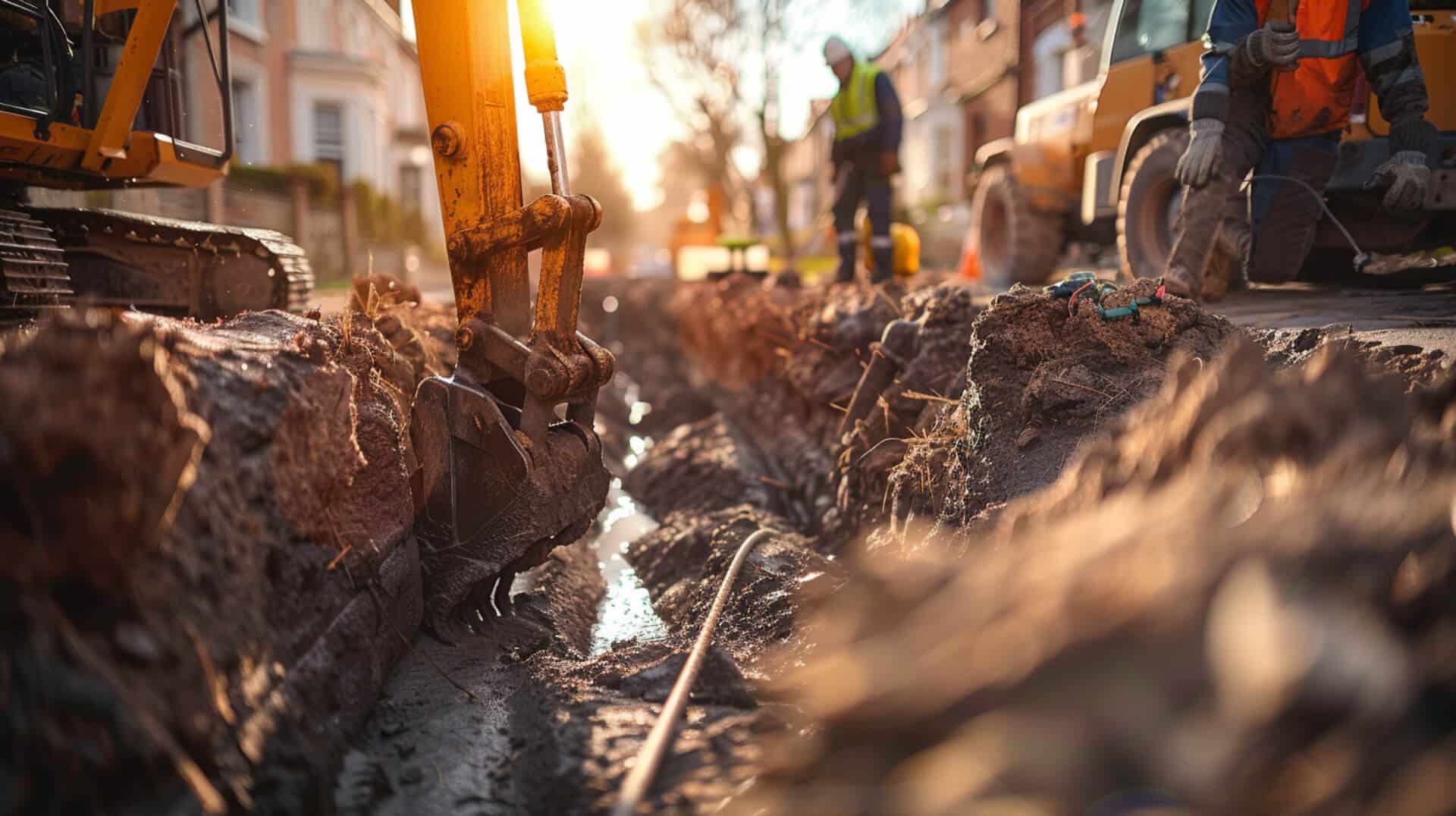
Drain excavation is a critical process for resolving severe drainage issues. When conventional methods fail to rectify problems within a drainage system, excavation becomes the necessary course of action. This process typically involves strategic digging to access and repair or replace damaged pipes.
When Is Drain Excavation Necessary?
Drain excavation is considered the most viable solution in scenarios where drainage systems are extensively compromised. Situations such as severe pipe damage, blockages that cannot be cleared with jetting equipment, or collapsed drains often require excavation.
The Process of Drain Excavation
The typical unfoldment of drain excavation begins with a comprehensive site assessment. This includes utilising CCTV surveys for underground mapping and planning safety measures to avoid utility damage. Only after these preliminary steps are taken, and the risks are understood and mitigated, does the physical process of excavation commence.
Preliminary Steps Before Excavation
Prior to initiating excavation, it is essential to conduct a thorough site assessment. This involves identifying the exact location of the problem using high-tech diagnostic tools and planning the excavation to ensure minimal disruption and risk. Safety planning against potential hazards, such as utility damage, is a crucial component of this phase.
Identifying Common Risks Associated with Drain Excavation
Drain excavation, while necessary for addressing severe drainage issues, carries inherent risks that must be carefully managed. Understanding these risks is essential for property owners, business owners, and facility managers to ensure the safety and integrity of the excavation site and its surroundings.
Risks to Underground Utilities
One of the primary concerns during excavation is the potential for damaging underground utilities, such as gas, water, and electricity lines. Accidental contact with these utilities can lead to service disruptions, costly repairs, and in some cases, serious safety hazards.
Worker Safety Concerns
The excavation site presents several safety risks to workers, including cave-ins, falls, and exposure to hazardous atmospheres. Ensuring worker safety is paramount, requiring strict adherence to safety protocols and the use of appropriate protective equipment.
Impact on Structural Integrity
Excavation can also affect the structural integrity of nearby buildings and infrastructure. Vibrations and soil displacement may cause unforeseen damage, necessitating measures to monitor and mitigate such impacts.
Mitigation Measures
To address these risks, several mitigation measures are employed:
– Comprehensive Site Assessment: Prior to excavation, a thorough assessment, including CCTV surveys and underground mapping, is conducted to identify and avoid utilities.
– Safety Protocols: Rigorous safety protocols, including soil and atmospheric testing, are implemented to protect workers.
– Structural Monitoring: Continuous monitoring of nearby structures helps to prevent damage and maintain integrity throughout the excavation process.
By recognising and addressing these risks, you can ensure that drain excavation is conducted safely and responsibly.
Pre-Excavation Assessments: A Critical Step
Before the first shovel hits the ground, a meticulous pre-excavation assessment is crucial. This phase is dedicated to ensuring that the forthcoming excavation does not lead to unintended consequences that could compromise the project’s integrity or safety.
The Role of Comprehensive Site Assessment
A comprehensive site assessment is indispensable, serving as the foundation for a successful excavation. It involves evaluating the proposed dig site to identify any existing underground utilities and to assess the potential risks that excavation poses to these and other subterranean features.
Utilising CCTV Surveys for Underground Mapping
CCTV surveys are a non-intrusive method that plays a pivotal role in underground mapping and risk assessment. By providing a clear view of the subsurface conditions, these surveys help in pinpointing the exact location of pipes and cables, thereby reducing the likelihood of accidental damage.
Safety Planning to Prevent Utility Damage
Safety planning is integral to the pre-excavation process. It involves strategizing to avoid utility damage, which includes marking utility lines and establishing clear digging protocols. This planning is essential to prevent service disruptions and ensure the safety of workers and the public.
Identifying and Addressing Potential Hazards
Potential hazards are identified through a combination of site assessments, CCTV surveys, and safety planning. Once identified, appropriate measures are taken to address these hazards, ensuring a safe and controlled excavation environment. This proactive approach is key to mitigating risks and ensuring a smooth excavation process.
The Excavation Process: Techniques and Tools
The excavation process for drain repair or replacement is a critical phase that demands precision and careful planning to minimise disruption and ensure safety.
Employing Techniques for Minimal Disruption
To ensure minimal disruption during excavation, a variety of techniques are employed. These include strategic digging to access the problem area directly and using tools that are appropriate for the specific conditions of the site. The goal is to achieve precise access to the damaged pipes while maintaining the integrity of the surrounding area.
Manual Digging Versus Mini-Excavators
When comparing manual digging to the use of mini-excavators, the choice often depends on the scale of the project and the sensitivity of the site. Manual digging allows for careful control in tight spaces, while mini-excavators can expedite the process in more open areas. Both methods require skilled operators to minimise the risk of utility damage and ensure precision.
Considerations for Excavation Method Selection
The selection of an excavation method is guided by several considerations, including the extent of the damage, the location of utilities, and the potential impact on the surrounding environment. The chosen method must balance efficiency with the need to protect existing structures and utilities.
Preparing and Managing the Excavation Site
Preparation and management of the excavation site are critical for safety and efficiency. This includes marking utility lines, setting up barriers for traffic control, and conducting soil and atmospheric testing to prevent hazardous conditions. Proper site management ensures that the excavation proceeds smoothly and safely, with risks managed and disruptions kept to a minimum.
Implementing Safety Measures During Excavation
Safety during drain excavation is paramount, with specific measures in place to protect workers and the public from the inherent risks of the process.
Protecting Workers from Cave-Ins and Hazardous Atmospheres
To safeguard against cave-ins, trench boxes and shoring are commonly used to stabilise the excavation walls. For protection from hazardous atmospheres, ventilation systems are installed when necessary, and workers are equipped with personal protective equipment, including respiratory protection when required.
Utility Mapping to Prevent Accidental Damage
Utility mapping is a critical step in the excavation process. It involves the use of electromagnetic equipment and ground-penetrating radar to detect and mark the location of underground utilities, thereby preventing accidental strikes that could lead to utility damage or dangerous leaks.
Traffic Control for Excavation Site Safety
Traffic control measures are essential, especially when excavation occurs in or near public thoroughfares. These measures may include the use of barriers, signs, and flaggers to direct vehicular and pedestrian traffic safely around the excavation site.
Soil and Atmospheric Testing for a Safe Environment
Soil and atmospheric testing are conducted to assess the conditions before and during the excavation. These tests help to identify potential toxic gases or unstable soil conditions, ensuring that the excavation environment remains safe for all personnel involved.
Post-Excavation Practices: Ensuring Site Restoration
After the completion of a drain excavation project, restoring the site to its original condition is a critical step that requires careful planning and execution.
Responsible Soil Storage During Excavation
During the excavation process, soil is often removed and must be stored responsibly to prevent environmental contamination and to facilitate easy restoration. Soil is typically stored on-site in designated areas, covered, and stabilised to prevent erosion or runoff.
Ensuring Structural Integrity Post-Excavation
Once the repair or replacement of drainage systems is complete, attention turns to ensuring the structural integrity of the excavation site. This involves compacting the soil properly, replacing the landscaping, and conducting inspections to confirm that the area is stable and safe for future use.
Conducting Post-Excavation Assessments
Post-excavation assessments are crucial to confirm the safety and success of the project. These assessments may include further CCTV surveys to ensure the repairs are secure and functioning as intended, as well as a final review of the site to ensure all safety standards have been met.
By adhering to these post-excavation practices, you can be confident that the site is restored to a safe and stable condition, mitigating any long-term risks associated with the excavation.
Exploring Alternatives to Traditional Excavation
In the realm of addressing drainage issues, traditional excavation is not always the only or the most suitable option. Alternatives to excavation can offer less disruptive, cost-effective solutions.
Drain Lining as a Non-Intrusive Method
Drain lining is a technique that serves as a less disruptive alternative to traditional excavation. This method involves inserting a new lining into the existing pipe, which then hardens and acts as a new pipe within the old one. It is particularly effective for repairing cracks or damage caused by root intrusion.
Non-Intrusive Fixes for Drainage Issues
Several non-intrusive fixes are available that do not require extensive digging:
– Jetting Equipment: High-pressure water jets can clear blockages and buildup within pipes.
– CCTV Diagnostics: Cameras are used to inspect pipes internally, identifying issues without excavation.
– Patch Repairs: Small sections of pipe can be repaired using localised patch liners, avoiding the need for full-scale excavation.
Preference for Non-Intrusive Solutions
Non-intrusive solutions are often preferred in situations where excavation poses a high risk to utilities, structures, or when it would cause significant disruption to the surrounding area.
Technological Advancements Supporting Drainage Solutions
Technological advancements have greatly enhanced the effectiveness of non-intrusive drainage solutions. Innovations in materials and techniques have made these methods more reliable, extending the life of pipes and reducing the need for future repairs.
Environmental Considerations in Drain Excavation
Drain excavation, while essential for infrastructure maintenance, necessitates careful environmental considerations to mitigate its impact.
Minimising Soil Excavation Impact
To minimise the environmental impact of soil excavation, strategies such as precise digging are employed to limit the area affected. Additionally, the use of silt fences and sediment basins helps control erosion and sediment runoff, protecting local waterways and ecosystems.
Managing Waste and Emissions
During excavation projects, managing waste and emissions is critical. Excavated material is sorted, with efforts made to recycle or reuse materials where possible. Emissions from machinery are monitored and reduced through the use of newer, more efficient equipment and adherence to strict maintenance schedules.
Protecting Local Ecosystems
Protective measures are taken to safeguard local ecosystems. These include establishing buffer zones around sensitive areas, using non-toxic biodegradable fluids in machinery, and scheduling work during periods that minimise disturbance to wildlife.
Assessing and Mitigating Deforestation Impact
When excavation projects involve deforestation, a thorough assessment is conducted to understand the potential impact. Mitigation strategies may include replanting trees, restoring habitats, and working with environmental specialists to ensure a balanced approach to development and conservation.
Groundwater and Geotechnical Challenges in Excavation
Understanding the geotechnical aspects of an excavation site is crucial for maintaining safety and stability throughout the excavation process.
Importance of Monitoring Groundwater Levels
Monitoring groundwater levels is essential during excavation as changes can affect soil stability and the structural integrity of the excavation site. High groundwater levels may require dewatering to prevent soil erosion or collapse, ensuring a safer work environment.
Impact of Soil Types on Excavation Safety
Different soil types, from sandy to clay-rich, present unique challenges during excavation. Soil analysis helps predict how the ground might shift or settle, allowing for appropriate measures to be taken to stabilise the excavation site and prevent cave-ins.
Guiding the Excavation Process with Geotechnical Considerations
Geotechnical considerations, such as soil composition and load-bearing capacity, guide the excavation process. These factors determine the appropriate excavation techniques and safety measures to be implemented, ensuring the process is conducted efficiently and without incident.
Addressing Geotechnical Challenges to Minimise Costs
Addressing geotechnical challenges proactively is key to minimising cost overruns. By conducting thorough geotechnical assessments before excavation begins, potential issues can be identified and addressed, reducing the likelihood of unexpected complications that could extend timelines and increase costs.
Navigating Legal and Regulatory Compliance
Adhering to legal and regulatory standards is a critical component of the drain excavation process. Compliance ensures the safety of workers, the public, and the environment.
Understanding Construction and Environmental Regulations
Construction and environmental regulations are designed to safeguard against the potential risks associated with excavation. These regulations encompass a range of requirements, from soil erosion control to the protection of wildlife habitats. Familiarising oneself with these regulations is essential for any excavation project.
The Influence of Worker Safety Laws on Excavation Practices
Worker safety laws dictate the measures that must be taken to protect individuals on-site. This includes the provision of protective equipment, training on safety procedures, and the implementation of emergency response plans. Compliance with these laws not only ensures worker safety but also helps to maintain project timelines and budgets by avoiding accidents and potential legal issues.
Consequences of Non-Compliance
Non-compliance with legal and regulatory standards can result in significant consequences, including fines, legal action, and project delays. It is imperative to understand and adhere to all relevant regulations to avoid these outcomes.
Ensuring Compliance Throughout the Excavation Process
Property owners can ensure compliance by:
– Engaging with qualified professionals who are well-versed in the relevant laws and regulations.
– Conducting regular audits and inspections throughout the excavation process.
– Maintaining open communication with regulatory bodies and responding promptly to any issues that arise.
By prioritising compliance, you can navigate the complexities of drain excavation with confidence, ensuring that the project proceeds smoothly and without legal entanglements.
Understanding the Costs of Drain Excavation
Drain excavation is a necessary but often costly endeavour, with various factors influencing the overall expense and duration of the project.
Factors Influencing Cost and Duration
The cost and duration of drain excavation projects are affected by several variables:
– Extent of Damage: More extensive damage requires longer repair times and increases costs.
– Site Accessibility: Difficult-to-access sites may necessitate specialised equipment or techniques, adding to the expense.
– Weather Conditions: Adverse weather can delay work and add to the project’s duration and cost.
– Repair Methods: The choice of repair method, whether traditional excavation or a trenchless alternative, can significantly impact the financial and temporal aspects of the project.
Managing Unexpected Complications
Unexpected complications, such as the discovery of previously unknown utilities or unstable soil conditions, can disrupt project timelines and inflate budgets. Proactive risk assessments and contingency planning are essential strategies to manage these potential issues effectively.
Reducing Costs with Preventive Maintenance
Preventive maintenance plays a crucial role in mitigating long-term excavation costs. Regular inspections and timely repairs can prevent minor issues from escalating into major problems that require extensive excavation.
By understanding these factors and implementing strategic planning and preventive maintenance, you can manage and potentially reduce the costs associated with drain excavation.
Mitigating Risks for Future Drain Excavation Success
Ensuring the longevity and reliability of drainage systems is a multifaceted endeavour that requires ongoing attention and proactive measures.
Regular Inspections and Maintenance
Regular inspections and maintenance are the first line of defence in preventing the need for future excavation. These practices allow for the early detection of potential issues, such as pipe degradation or blockages, which can be addressed before they escalate into more significant problems requiring excavation.
Public Education on Waste Disposal
Educating the public on proper waste disposal plays a crucial role in preventing drainage issues. By understanding what should and should not enter the drainage system, individuals can help to prevent blockages and damage that could lead to the need for excavation.
Investment in Infrastructure Modernization
Investing in the modernization of drainage infrastructure is a proactive step towards mitigating the risks associated with misconnected drains and sewers. Upgrading to more durable materials and implementing advanced technologies can reduce the frequency and severity of drainage issues.
Key Takeaways for Stakeholders
For property owners, business owners, and facility managers, the key takeaways include:
– Recognising the importance of regular maintenance to prevent costly excavations.
– Contributing to public education efforts on proper waste disposal.
– Considering the long-term benefits of investing in infrastructure modernization.
By adhering to these practices, stakeholders can ensure the safety and success of their drainage systems and minimise the potential for future excavation-related complications.
